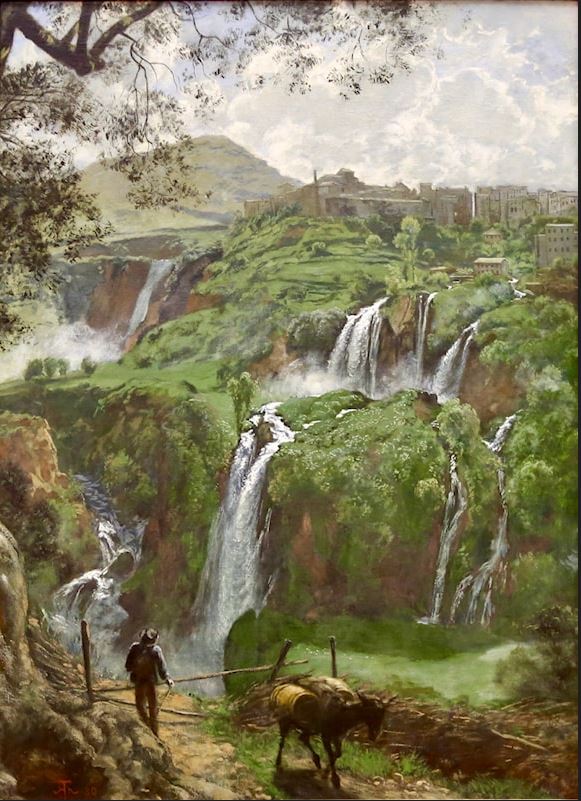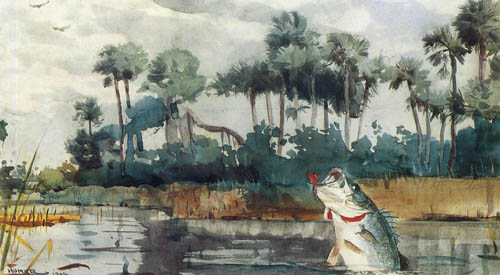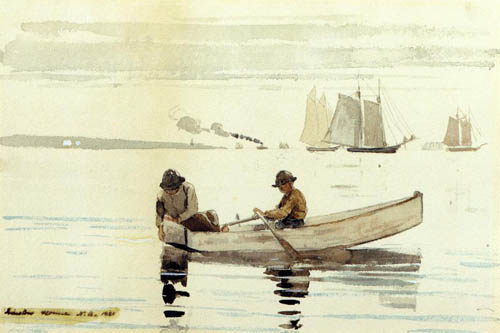Winslow Homer (February 24, 1836 – September 29, 1910) was an American landscape painter and printmaker, best known for his marine subjects. He is considered one of the foremost painters in 19th century America and a preeminent figure in American art.
Largely self-taught, Homer began his career working as a commercial illustrator. He subsequently took up oil painting and produced major studio works characterized by the weight and density he exploited from the medium. He also worked extensively in watercolor, creating a fluid and prolific oeuvre, primarily chronicling his working vacations.
Unlike many artists who were well known for working in only one art medium, Winslow Homer was prominent in a variety of art media.
Early landscapes and watercolors
After exhibiting at the National Academy of Design, Homer finally traveled to Paris, France in 1867 where he remained for a year. His most praised early painting, Prisoners from the Front, was on exhibit at the Exposition Universelle in Paris at the same time. He did not study formally but he practiced landscape painting while continuing to work for Harper's, depicting scenes of Parisian life.
Homer painted about a dozen small paintings during the stay. Although he arrived in France at a time of new fashions in art, Homer's main subject for his paintings was peasant life, showing more of an alignment with the established French Barbizon school and the artist Millet than with newer artists Manet and Courbet. Though his interest in depicting natural light parallels that of the early impressionists, there is no evidence of direct influence as he was already a plein-air painter in America and had already evolved a personal style which was much closer to Manet than Monet. Unfortunately, Homer was very private about his personal life and his methods (even denying his first biographer any personal information or commentary), but his stance was clearly one of independence of style and a devotion to American subjects. As his fellow artist Eugene Benson wrote, Homer believed that artists "should never look at pictures" but should "stutter in a language of their own."
Throughout the 1870s, Homer continued painting mostly rural or idyllic scenes of farm life, children playing, and young adults courting, including Country School (1871) and The Morning Bell (1872). In 1875, Homer quit working as a commercial illustrator and vowed to survive on his paintings and watercolors alone. Despite his excellent critical reputation, his finances continued to remain precarious. His popular 1872 painting Snap-the-Whip was exhibited at the 1876 Centennial Exposition in Philadelphia, Pennsylvania, as was one of his finest and most famous paintings Breezing Up (1876). Of his work at this time, Henry James wrote:
We frankly confess that we detest his subjects...he has chosen the least pictorial range of scenery and civilization; he has resolutely treated them as if they were pictorial...and, to reward his audacity, he has incontestably succeeded."
Many disagreed with James. Breezing Up, Homer's iconic painting of a father and three boys out for a spirited sail, received wide praise. The New York Tribune wrote, "There is no picture in this exhibition, nor can we remember when there has been a picture in any exhibition, that can be named alongside this." Visits to Petersburg, Virginia around 1876 resulted in paintings of rural African American life. The same straightforward sensibility which allowed Homer to distill art from these potentially sentimental subjects also yielded the most unaffected views of African American life at the time, as illustrated in Dressing for the Carnival (1877) and A Visit from the Old Mistress (1876).
In 1877, Homer exhibited for the first time at the Boston Art Club with the oil painting, An Afternoon Sun, (owned by the Artist). From 1877 through 1909 Homer exhibited often at the Boston Art Club. Works on paper, both drawings and watercolors, were frequently exhibited by Homer beginning in 1882. A most unusual sculpture by the Artist, Hunter with Dog - Northwoods, was exhibited in 1902. By that year, Homer had switched his primary Gallery from the Boston based Doll and Richards to the New York City based Knoedler & Co.
Homer became a member of The Tile Club, a group of artists and writers who met frequently to exchange ideas and organize outings for painting, as well as foster the creation of decorative tiles. For a short time, he designed tiles for fireplaces. Homer's nickname in The Tile Club was "The Obtuse Bard". Other well known Tilers were painters William Merritt Chase, Arthur Quartley, and the sculptor Augustus Saint Gaudens.
Fisherwomen, Cullercoats, graphite and watercolor on paper 1881, Honolulu Museum of Art
Homer started painting with watercolors on a regular basis in 1873 during a summer stay in Gloucester, Massachusetts. From the beginning, his technique was natural, fluid and confident, demonstrating his innate talent for a difficult medium. His impact would be revolutionary. Here, again, the critics were puzzled at first, "A child with an ink bottle could not have done worse." Another critic said that Homer "made a sudden and desperate plunge into water color painting". But his watercolors proved popular and enduring, and sold more readily, improving his financial condition considerably. They varied from highly detailed (Blackboard – 1877) to broadly impressionistic (Schooner at Sunset – 1880). Some watercolors were made as preparatory sketches for oil paintings (as for "Breezing Up") and some as finished works in themselves. Thereafter, he seldom traveled without paper, brushes and water based paints.
As a result of disappointments with women or from some other emotional turmoil, Homer became reclusive in the late 1870s, no longer enjoying urban social life and living instead in Gloucester. For a while, he even lived in secluded Eastern Point Lighthouse (with the keeper's family). In re-establishing his love of the sea, Homer found a rich source of themes while closely observing the fishermen, the sea, and the marine weather. After 1880, he rarely featured genteel women at leisure, focusing instead on working women.
Maine and maturity
Back in the U.S. in November 1882, Homer showed his English watercolors in New York. Critics noticed the change in style at once, "He is a very different Homer from the one we knew in days gone by", now his pictures "touch a far higher plane...They are works of High Art." Homer's women were no longer "dolls who flaunt their millinery" but "sturdy, fearless, fit wives and mothers of men" who are fully capable of enduring the forces and vagaries of nature along side their men.
In 1883, Homer moved to Prouts Neck, Maine (in Scarborough) and lived at his family's estate in the remodeled carriage house just seventy-five feet from the ocean. During the rest of the mid-1880s, Homer painted his monumental sea scenes. In Undertow (1886), depicting the dramatic rescue of two female bathers by two male lifeguards, Homer's figures "have the weight and authority of classical figures". In Eight Bells (1886), two sailors carefully take their bearings on deck, calmly appraising their position and by extension, their relationship with the sea; they are confident in their seamanship but respectful of the forces before them. Other notable paintings among these dramatic struggle-with-nature images are Banks Fisherman, The Gulf Stream, Rum Cay, Mending the Nets, and Searchlight, Harbor Entrance, Santiago de Cuba. Some of these he repeated as etchings.
At fifty years of age, Homer had become a "Yankee Robinson Crusoe, cloistered on his art island" and "a hermit with a brush". These paintings established Homer, as the New York Evening Post wrote, "in a place by himself as the most original and one of the strongest of American painters."[31] But despite his critical recognition, Homer's work never achieved the popularity of traditional Salon pictures or of the flattering portraits by John Singer Sargent. Many of the sea pictures took years to sell and Undertow only earned him $400.
In these years, Homer received emotional sustenance primarily from his mother, brother Charles, and sister-in-law Martha ("Mattie"). After his mother's death, Homer became a "parent" for his aging but domineering father and Mattie became his closest female intimate.[35] In the winters of 1884-5, Homer ventured to warmer locations in Florida, Cuba, and the Bahamas, and did a series of watercolors as part of a commission for Century Magazine. He replaced the turbulent green storm-tossed sea of Prouts Neck with the sparkling blue skies of the Caribbean, and the hardy New Englanders with the leisurely Black natives, further expanding his watercolor technique, subject matter, and palette. During this trip he painted Children Under a Palm Tree for Lady Blake, the Governor's wife. His tropical stays inspired and refreshed him in much the same way as Paul Gauguin's trips to Tahiti. A Garden in Nassau (1885) is one of the best examples of these watercolors. Once again, his freshness and originality were praised by critics, but proved too advanced for the traditional art buyers and he "looked in vain for profits." Homer lived frugally, however, and fortunately, his affluent brother Charles provided financial help when needed.
Additionally, Homer found inspiration in a number of summer trips to the North Woods Club, near the hamlet of Minerva, New York in the Adirondack Mountains. It was on these fishing vacations that he experimented freely with the watercolor medium, producing works of the utmost vigor and subtlety, hymns to solitude, nature, and to outdoor life. Homer doesn't shrink from the savagery of blood sports nor the struggle for survival. The color effects are boldly and facilely applied. In terms of quality and invention, Homer's achievements as a watercolorist are unparalleled: "Homer had used his singular vision and manner of painting to create a body of work that has not been matched."
In 1893, Homer painted one of his most famous "Darwinian" works, The Fox Hunt, which depicts a flock of starving crows descending on a fox slowed by deep snow. This was Homer's largest painting and it was immediately purchased by the Pennsylvania Academy of the Fine Arts, his first painting in a major American museum collection. In Huntsman and Dogs (1891), a lone, impassive hunter, with his yelping dogs at his side, heads home after a hunt, with deer skins slung over his right shoulder. Another late work, The Gulf Stream (1899), shows a Black sailor adrift in a damaged boat, surrounded by sharks and an impending maelstrom.
By 1900, Homer finally reached financial stability, as his paintings fetched good prices from museums and he began to receive rents from real estate properties. He also became free of the responsibilities of caring for his father who had died two years earlier. Homer continued producing excellent watercolors, mostly on trips to Canada and the Caribbean. Other late works include sporting scenes such as Right and Left, as well as seascapes absent of human figures, mostly of waves crashing against rocks in varying light. In his last decade, he at times followed the advice he gave a student artist in 1907, "Leave rocks for your old age—they're easy".
Homer died in 1910 at the age of 74 in his Prouts Neck studio and was interred in the Mount Auburn Cemetery in Cambridge, Massachusetts. His painting, Shooting the Rapids, Saguenay River, remains unfinished.
His Prouts Neck studio is now owned by the Portland Museum of Art.












